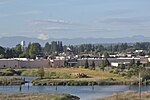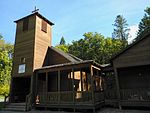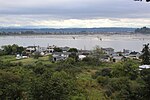Quil Ceda Village

Quil Ceda Village (Lushootseed: qʷəl'sidəʔ ʔalʔaltəd) is a municipality established by the federally recognized Tulalip Tribes of Washington within the Tulalip Indian Reservation in Snohomish County. It includes the Quil Ceda Village Business Park, a commercial development constructed and operated by the tribe. The tribe developed the 495-acre (200.32 hectare) village and related business park to further its goal to diversify its economy with funds generated by its successful casino operations, the first enterprise in the business park. The Business Park contains the Tulalip Resort Casino, big box stores Walmart and The Home Depot, Seattle Premium Outlets (a 500,000-square foot (46,452-square meter), 125-tenant open-air mall opened in 2005), Cabela's, and several restaurants, such as Olive Garden and the Ram Brewery.The land was originally home to a testing site that was leased by the United States Department of Defense for ammunition storage in the 1940s and 1950s and later Boeing for jet engine testing until 2000. The retail section began with Walmart and The Home Depot stores in 2001.
Excerpt from the Wikipedia article Quil Ceda Village (License: CC BY-SA 3.0, Authors, Images).Quil Ceda Village
Rainwater Road,
Geographical coordinates (GPS) Address Nearby Places Show on map
Geographical coordinates (GPS)
| Latitude | Longitude |
|---|---|
| N 48.085555555556 ° | E -122.20638888889 ° |
Address
Rainwater Road
Rainwater Road
98271
Washington, United States
Open on Google Maps








